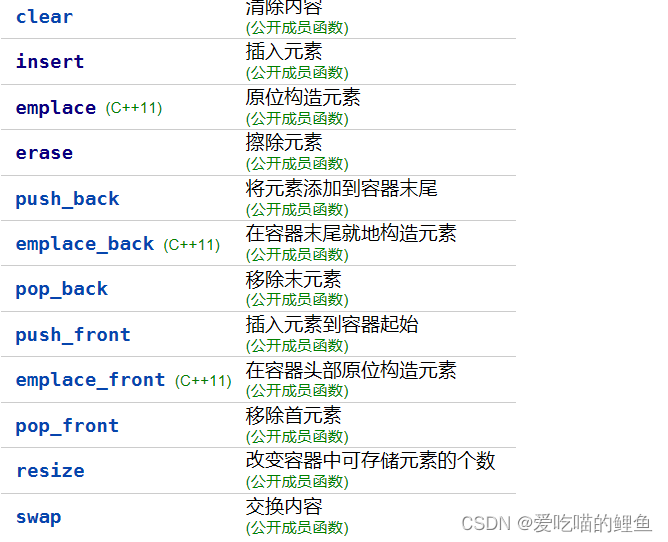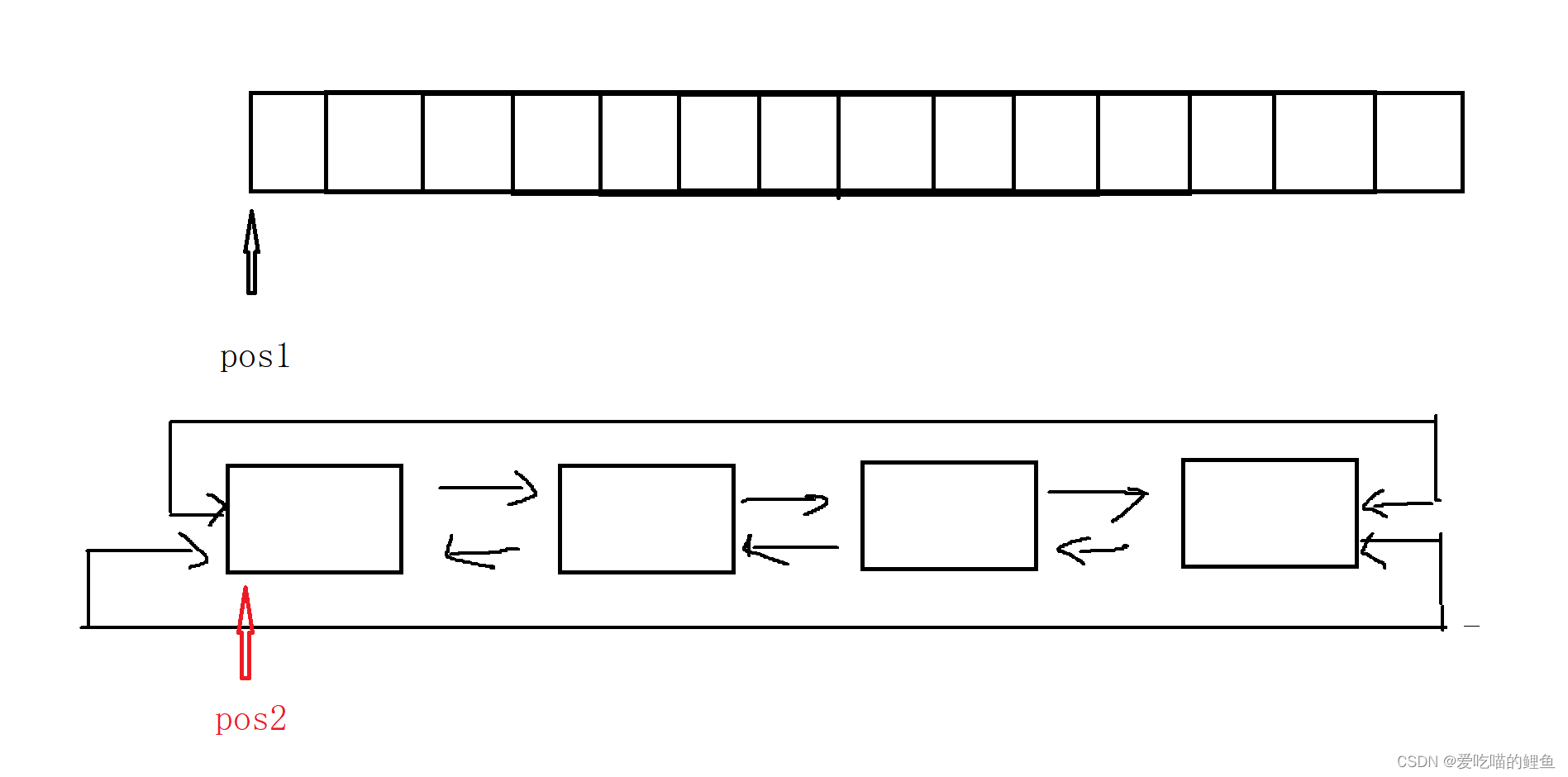在C语言中我们已经模拟实现了list,现在对比c++看看二者的区别
个人博客主页:
文章目录
链表就像这个火车
前言
1. list是可以在常数范围内在任意位置进行插入和删除的序列式容器,并且该容器可以前后双向迭代。
2. list的底层是双向链表结构,双向链表中每个元素存储在互不相关的独立节点中,在节点中通过指针指向 其前一个元素和后一个元素。
3. list与forward_list非常相似:最主要的不同在于forward_list是单链表,只能朝前迭代,已让其更简单高 效。
4. 与其他的序列式容器相比(array,vector,deque),list通常在任意位置进行插入、移除元素的执行效率 更好。
5. 与其他序列式容器相比,list和forward_list最大的缺陷是不支持任意位置的随机访问,比如:要访问list 的第6个元素,必须从已知的位置(比如头部或者尾部)迭代到该位置,在这段位置上迭代需要线性的时间 开销;list还需要一些额外的空间,以保存每个节点的相关联信息(对于存储类型较小元素的大list来说这 可能是一个重要的因素)
一、list是什么?
list就是带头双向链表,头节点存有链表的最后一个节点的地址和第一个节点的地址(链表的物理空间是不连续的,每一个节点的物理空间都是独立的),每一个节点中都存有上一个节点的地址和下一个节点的地址。
二、list的使用
list中的接口比较多,此处类似,只需要掌握如何正确的使用,然后再去深入研究背后的原理,已达到可扩展 的能力。以下为list中一些常见的重要接口。




#include <iostream>
#include <list>
#include <vector>
#include <algorithm>
using namespace std;
#include <time.h>
void test_list1()
{
//定义链表和插入数据
list<int> lt;
lt.push_back(1);
lt.push_back(2);
lt.push_back(3);
lt.push_back(4);
//迭代器的遍历
list<int>::iterator it = lt.begin();
while (it != lt.end())
{
cout << *it << " ";
++it;
}
cout << endl;
for (auto e : lt)
{
cout << e <<" ";
}
cout << endl;
//查找节点插入数据
list<int>::iterator pos = find(lt.begin(), lt.end(), 3);
if (pos != lt.end())
{
lt.insert(pos, 30);
}
for (auto e : lt)
{
cout << e << " ";
}
cout << endl;
}这里的迭代器的使用和vector一样但是这两个迭代器底层有着非常大的差距 ,在下面的模拟实现中会非常细致的讲解
思考:pos1++和pos2++的区别,这两个指针哪一个可以找到下一个元素的地址???
提示:曾经的顺序表和链表的关系。

void test_list2()
{
list<int> lt;
lt.push_back(10);
lt.push_back(2);
lt.push_back(5);
lt.push_back(3);
lt.push_back(4);
lt.push_back(4);
lt.push_back(6);
lt.push_back(4);
lt.push_back(0);
for (auto e : lt)
{
cout << e << " ";
}
cout << endl;
lt.sort();
// 迭代器功能分类
// 1、单向 ++
// 2、双向 ++ --
// 3、随机 ++ -- + -
//sort(lt.begin(), lt.end());
for (auto e : lt)
{
cout << e << " ";
}
cout << endl;
}
三、模拟实现list和搭建list的结构
1.节点结构
代码如下(示例):
template<class T>//用到了类模板,由于我们想要插入任意类型的数据
struct list_node
{
list_node<T>* _next;
list_node<T>* _prev;
T _data;
list_node(const T& x = T())//对成员的默认初始化,这个也是一个匿名构造。
:_next(nullptr)//初始化时将节点的下一个节点个下一个节点都置空
, _prev(nullptr)
, _data(x)//插入x
{}
};1.在c语言中,结构体用的是struct,而在c++中我们也可以使用,它和calss相似,如果在一个类里面不需要区分共有成员和私有成员,我们就可以用struct。因为都是自定义类型所以我们需要对它进行成员的初始化。
2.在这个节点中我们存在着后面对成员的访问权限问题,所以我们选择使用struct。
2.迭代器的详讲(这是和vector的区别)
代码如下(示例):
// 1、迭代器要么就是原生指针
// 2、迭代器要么就是自定义类型对原生指针的封装,模拟指针的行为
template<class T, class Ref, class Ptr>//类模板可以有多个参数,T是原生类型,也就是普通类型
//ref是const类型,不可进行修改;ptr是指针类型。
struct __list_iterator
{
typedef list_node<T> node;
typedef __list_iterator<T, Ref, Ptr> self;
node* _node;
__list_iterator(node* n)
:_node(n)
{}
Ref operator*()//对*的重载,返回为const类型。
{
return _node->_data;
}
Ptr operator->()//对->的重载,->用在对地址的访问,也就是见引用node地址处的date
{
return &_node->_data;
}
self& operator++()//这里的++是前置++,返回的类型是节点类型,而不是节点的指针,在C语言中是一个地址
{
_node = _node->_next;
return *this;
}
self operator++(int)//后置++,+了一个int类型进行对前置++的区分
{
self tmp(*this);
_node = _node->_next;
return tmp;
}
self& operator--()
{
_node = _node->_prev;
return *this;
}
self operator--(int)
{
self tmp(*this);
_node = _node->_prev;
return tmp;
}
bool operator!=(const self& s)
{
return _node != s._node;
}
bool operator==(const self& s)
{
return _node == s._node;
}
};1.类模板中提到过,一个模板可以有多个模板参数,每一个模板可以控制某一种类型。
2.我们的类模板功能非常强大,到我们想要写一个类,但是这个类要写两者类型时,我们需要写两个类出来,但是用了模板我们只需要加一个模板参数即可;
3.“->”用于地址访问和见引用,而“."用于类的成员访问,二者都是见引用的作用。
template<class T>
class list
{
typedef list_node<T> node;
public:
typedef __list_iterator<T, T&, T*> iterator;
typedef __list_iterator<T, const T&, const T*> const_iterator;
iterator begin()
{
//iterator it(_head->_next);
//return it;
return iterator(_head->_next);
}
const_iterator begin() const
{
return const_iterator(_head->_next);
}
iterator end()
{
return iterator(_head);
}
const_iterator end() const
{
//iterator it(_head->_next);
//return it;
return const_iterator(_head);
}因为在迭代器中我们的”*“重载即用了普通类型,也用了const类型,所以我们单独给它一个名字Ref,当我们用const类型迭代器时,传递过来的模板参数是const。这是*重载就是const类型。
3.list基础结构
template<class T>
class list
{
typedef list_node<T> node;
public:
typedef __list_iterator<T, T&, T*> iterator;
typedef __list_iterator<T, const T&, const T*> const_iterator;
list(const list<T>& lt)//拷贝构造
{
empty_init();
list<T> tmp(lt.begin(), lt.end());
swap(tmp);
}
void empty_init()
{
_head = new node;
_head->_next = _head;
_head->_prev = _head;
}
list()//默认构造
{
empty_init();
}
template <class Iterator>
list(Iterator first, Iterator last)//区间拷贝构造
{
empty_init();
while (first != last)
{
push_back(*first);
++first;
}
~list()
{
clear();
delete _head;
_head = nullptr;
}
private:
node* _head;
};
4.修改器
void swap(list<T>& tmp)//交换两个节点
{
std::swap(_head, tmp._head);
}
void clear()//清空内容
{
iterator it = begin();
while (it != end())
{
//it = erase(it);
erase(it++);
}
}
void push_back(const T& x)//尾插
{
/*node* tail = _head->_prev;
node* new_node = new node(x);
tail->_next = new_node;
new_node->_prev = tail;
new_node->_next = _head;
_head->_prev = new_node;*/
insert(end(), x);
}
void push_front(const T& x)//头插
{
insert(begin(), x);
}
void pop_back()//尾删
{
erase(--end());
}
void pop_front()//头删
{
erase(begin());
}
void insert(iterator pos, const T& x)//任意位置插入
{
node* cur = pos._node;
node* prev = cur->_prev;
node* new_node = new node(x);
prev->_next = new_node;
new_node->_prev = prev;
new_node->_next = cur;
cur->_prev = new_node;
}
iterator erase(iterator pos)//任意位置删除
{
assert(pos != end());
node* prev = pos._node->_prev;
node* next = pos._node->_next;
prev->_next = next;
next->_prev = prev;
delete pos._node;
return iterator(next);
}有了insert函数,我们就不需要push_back和push_front函数了,erase也是;
四、测试list
void test_list1()
{
const list<int> lt1;
const int n = 10;
//n = 11;
list<int> lt;
lt.push_back(1);
lt.push_back(2);
lt.push_back(3);
lt.push_back(4);
// int*
list<int>::iterator it = lt.begin();
while (it != lt.end())
{
(*it) *= 2;
cout << *it << " ";
++it;
}
cout << endl;
for (auto e : lt)
{
cout << e << " ";
}
cout << endl;
print_list(lt);
}
struct AA
{
int _a1;
int _a2;
AA(int a1 = 0, int a2 = 0)
:_a1(a1)
, _a2(a2)
{}
};
void test_list2()
{
list<AA> lt;
lt.push_back(AA(1, 1));
lt.push_back(AA(2, 2));
lt.push_back(AA(3, 3));
// AA* ptr
list<AA>::iterator it = lt.begin();
while (it != lt.end())
{
//cout << (*it)._a1 << ":" << (*it)._a2 << endl;
cout << it->_a1 << ":" << it->_a2 << endl;
//cout << it.operator->()->_a1 << ":" << it.operator->()->_a1 << endl;
++it;
}
cout << endl;
}
void test_list3()
{
list<int> lt;
lt.push_back(1);
lt.push_back(2);
lt.push_back(3);
lt.push_back(4);
for (auto e : lt)
{
cout << e << " ";
}
cout << endl;
auto pos = lt.begin();
++pos;
lt.insert(pos, 20);
for (auto e : lt)
{
cout << e << " ";
}
cout << endl;
lt.push_back(100);
lt.push_front(1000);
for (auto e : lt)
{
cout << e << " ";
}
cout << endl;
lt.pop_back();
lt.pop_front();
for (auto e : lt)
{
cout << e << " ";
}
cout << endl;
}
void test_list4()
{
list<int> lt;
lt.push_back(1);
lt.push_back(2);
lt.push_back(3);
lt.push_back(4);
for (auto e : lt)
{
cout << e << " ";
}
cout << endl;
lt.clear();
for (auto e : lt)
{
cout << e << " ";
}
cout << endl;
lt.push_back(10);
lt.push_back(2);
lt.push_back(3);
lt.push_back(40);
for (auto e : lt)
{
cout << e << " ";
}
cout << endl;
}
void test_list5()
{
list<int> lt;
lt.push_back(1);
lt.push_back(2);
lt.push_back(3);
lt.push_back(4);
lt.push_back(5);
for (auto e : lt)
{
cout << e << " ";
}
cout << endl;
list<int> lt2(lt);
for (auto e : lt2)
{
cout << e << " ";
}
cout << endl;
list<int> lt3;
lt3.push_back(10);
lt3.push_back(20);
lt3.push_back(30);
for (auto e : lt3)
{
cout << e << " ";
}
cout << endl;
lt2 = lt3;
for (auto e : lt2)
{
cout << e << " ";
}
cout << endl;
for (auto e : lt3)
{
cout << e << " ";
}
cout << endl;
}总结
迭代器中的类模板
修改器的insert和erase
了解list的基本结构























 825
825











 被折叠的 条评论
为什么被折叠?
被折叠的 条评论
为什么被折叠?










